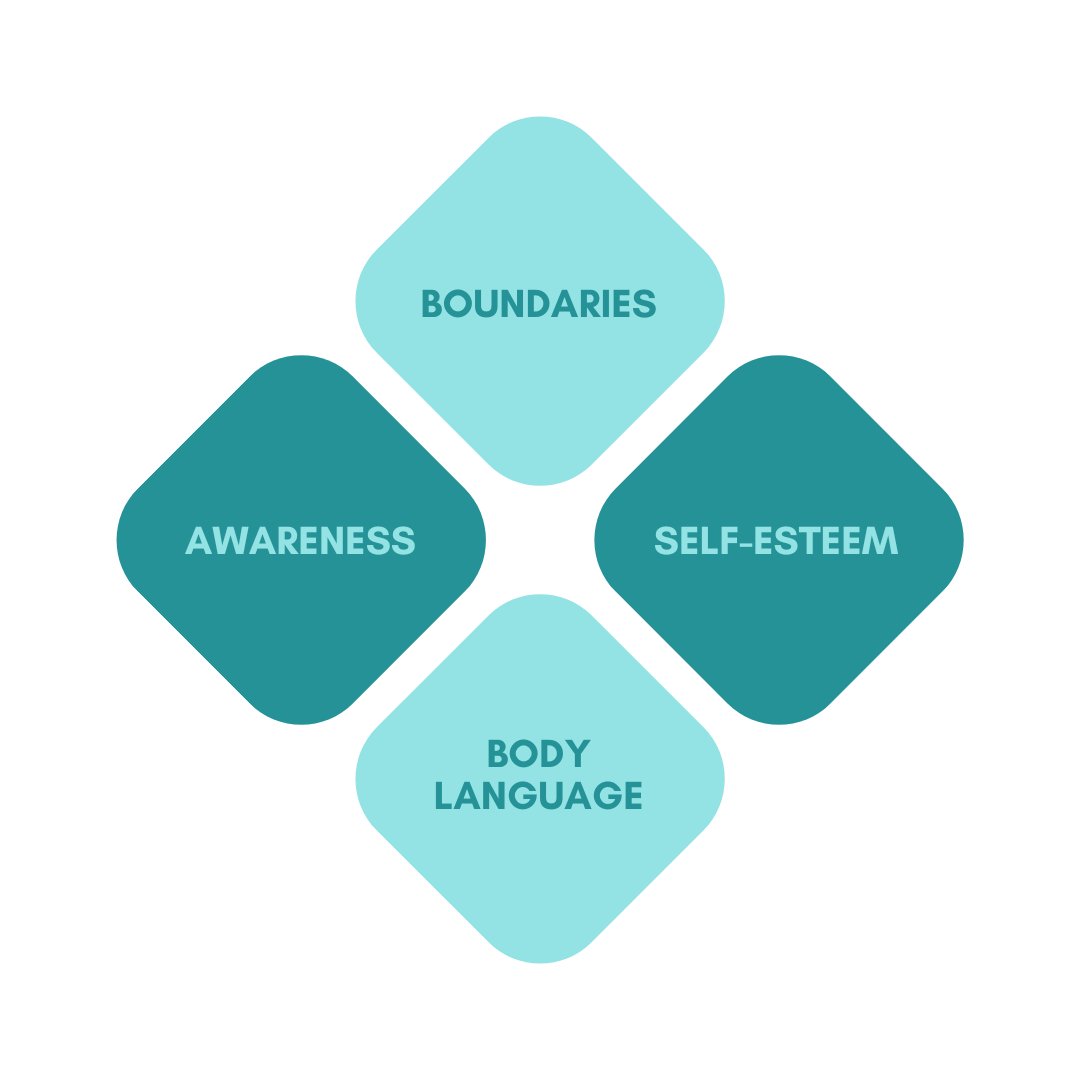Elements of Self-Defense
Even with knowledge of red flags and predator strategies, there is no way to truly know the type of predator you can encounter. Despite this uncertainty, it is still wise to invest in prevention factors that neutralize or minimize one’s potentiality for target selection.
Although these are not foolproof, as some predators are persistent, it is better to have safeguards than none at all. The development of self-esteem and boundaries is not only useful for self-protection, but can also contribute to healthy and mutually-beneficial social interactions.
-
Self-defense begins with the belief that you are worth defending, and this heightened sense of worth is also known as self-esteem. A person with high self-esteem is also unlikely to escalate potential antisocial violence, as these conflicts are often the result of a target who is easily goaded into a fight by the aggressor.
Self-esteem is not a fixed state, it can be destroyed by toxic behaviors or cultivated with healthy ones. Build your self-esteem by frequently:
• Practicing self-care (e.g., getting enough rest, proper nutrition)
• Cultivating a skill that you enjoy and can share with others (e.g., sports, music, art)
• Persevering through healthy challenges (e.g., studying better after failing a test)
• Surrounding yourself with genuine people who support and encourage you
• Seeking help when needed
• Cutting off toxic people and activities (e.g., eliminate drug and alcohol use as “stress relief”)
-
Confident body language is easier to project when one already has high self-esteem. Experts have identified that 70-90% of communication is nonverbal, that how you speak or carry yourself shows more than what you say. Since predators mainly choose easy, low-risk targets (e.g., those who look insecure and passive) , make yourself an undesirable, high-risk target (e.g., those who project assertiveness and strength) by exhibiting confident body language:
• Sit, stand, or walk tall (do not slouch or hunch your shoulders)
• Keep your distance (arm's length apart if possible) if someone invades your space
• Eyes up to see surroundings
• Make eye contact when speaking
• Speak slowly and clearly with a calm, firm tone
• Avoid fidgeting
-
The more you see and hear, the more you are aware, and the easier it will be to identify (if there are any) threats and opportunities to escape. Many predators rely on targets who appear unaware (e.g., a passenger on the bus wearing headphones and staring at their phone), so don’t make yourself an easy target by being distracted. Whenever you are out in public, observe your surroundings:
• Are you in a well-lit or dark, isolated or public place?
• Where are the exits? Are there areas where you can access help if needed?
• Who is around? What are they doing?
• What is going on? Does something feel out of place?
-
Having healthy physical and emotional boundaries is crucial to identifying inappropriate and potentially dangerous behavior. Recognizing when your boundaries are being crossed is essential to defending them. Note that boundaries vary based on an individual’s personality, culture, mood, their relationship with the person and the circumstances surrounding their behavior. Your boundaries may not be the same as other people in your life, but regardless of the differences, they should still be respected.
• PHYSICAL: Boundaries regarding the area you consider your personal space, including what you consider appropriate touch or comments about your appearance.
e.g., You are comfortable hugging family but uncomfortable hugging coworkers or new acquaintances.
• EMOTIONAL: Boundaries that deal with levels of comfort when expressing emotions, sharing and hearing personal details, and having your emotions respected instead of dismissed or minimized.
e.g., When your friends notice you’re upset, they let you come to them when you are ready to talk instead of demanding an immediate explanation.
• SEXUAL: Boundaries that deal with your emotional and physical expectations of sex and sexuality, including your consent, preferences, and privacy.
e.g., You are comfortable discussing your dating life with your best friend, but not with an estranged relative.
• MATERIAL: Boundaries that deal with how much you share your money or possessions, or the way your possessions are treated.
e.g., You expect your friend to return a borrowed book to you on time and without damages.
• TIME/ENERGY: Boundaries relate to the frequency and expectations around your time and energy.
e.g., You take a break from back-to-back gatherings to get rest.
People will test your boundaries, and while not all boundary breaches lead to violence or abuse, they can still impact one's self-esteem and sense of security. Even if the behavior is nonviolent, you should still protect your boundaries to first, prevent further boundary breaches and second, identify if the person is a threat or not.
“One need not destroy one’s enemy. One need only destroy his willingness to engage.”
S U N T Z U
-
• de Becker, Gavin. "The Gift of Fear." Dell Publishing. 1998.
• Galbraith, Molly. “Strong Women Lift Each Other Up.” Harper Horizon. 2021.
• Mattingly, Katy. “Self-Defense Steps to Survival: A Proven Plan for Personal Protection.” Human Kinetics. 2007.
• Miller, Rory. “Conflict Communication: A New Paradigm in Conscious Communication.” YMAA Publishing Centre. 2015.
• Murphy, Kylie A. "Girls at Risk of Chronic Partner Abuse: Assertive Tendency, Warning Signs, Risk Sensitivity, and Self-Confidence." Journal of Relationships Research. Vol. 2. 2011.
—-. “Partner Abuse Prevention Education: An Integrative Approach to Program Development and Evaluation.” Partner Abuse, Vol. 4. 2013.
• Navarro, Joe and Marvin Karlins. "What Every Body Is Saying." HarperCollins. 2008.
• Sochting, Ingrid, Fairbrother, N., & Koch, W. J. “Sexual Assault of Women: Prevention Efforts and Risk Factors.” Violence Against Women, Vol. 10. 2004.



